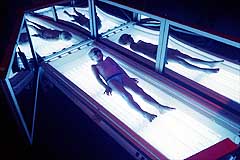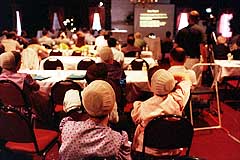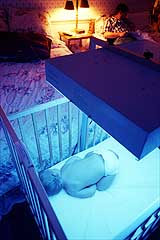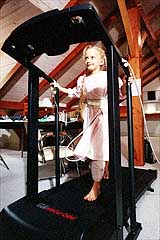June 29, 1999
At Gene Therapy's Frontier, the Amish Build a Clinic
By DENISE GRADY
STRASBURG, Pa. -- This was not the
typical audience for a medical conference, but then again, this was no typical conference. At an inn set in the lush farmland of Lancaster County,
doctors attending scientific lectures earlier this month were joined by young Mennonite and Amish couples, the women in bonnets and the men in
suspenders, babies fussing in their laps.
|

Sal DiMarco Jr. for The New York Times |
Children with Crigler-Najjar
syndrome lack a liver enzyme crucial for removing a toxic substance, bilirubin,
from the blood. Special lights that break down bilirubin can help. Six-year-old
Chris Platt in a $30,000 mirrored bed.
|
The Amish and Mennonites may travel by horse and buggy and forgo most modern
conveniences, but there is one bit of progress that they are eager to embrace:
gene therapy.
If all goes as planned, conference participants learned, three children
from these communities will become the first human beings to test a new
method of gene therapy. If it works, it will spare them the devastating
effects of a rare but deadly inherited disease.
In the condition, Crigler-Najjar syndrome, a substance
called bilirubin, a waste product from the destruction of worn-out red
blood cells, builds up in the body.
Bilirubin is produced constantly in the human body, and normally, it
is broken down by an enzyme in the liver and excreted through the intestines.
But in people with the syndrome, the enzyme is either absent or scarce.
Bilirubin accumulates, causing jaundice, a yellowing of the skin and the
whites of the eyes. More important, bilirubin is toxic to the nervous system,
and the children live in constant danger of brain damage.
The only way they can survive is to spend 10 to 12 hours a day under
special lights that break down the bilirubin. But as they reach their teens,
the light therapy becomes less effective. Unless they can get a liver transplant,
they may suffer brain damage or die.
If gene therapy works, the children will have a chance to lead more
normal lives. But previous attempts at gene therapy for other diseases
have been disappointing. If the new approach, called chimeraplasty, succeeds
against Crigler-Najjar syndrome, it would finally open the
door to treatment of a host of other, more common genetic disorders, according
to Dr. Michael Blaese, a gene therapy expert who left the National Institutes
of Health in January to join a Philadelphia company specializing in the
new therapy. The other disorders that might be treated include sickle cell
anemia, cystic fibrosis and a failure of the immune system known as ADA
deficiency.
|

Sal DiMarco Jr. for The New York Times |
Amish and Mennonite families, hearing about a new approach to gene therapy that may hope will help children with an
inherited liver disorder.
|
"I left what I thought was the best job in the world to do this because I believe so strongly in it and believe we'll be successful," Dr. Blaese
said. "I think it will really fundamentally change the way we practice medicine."
A MISSION
Doctor Draws Others to Help the Children
Dr. Blaese and other researchers, leaders in genetics and disorders involving bilirubin,
were drawn to Lancaster County largely through the efforts of Dr. Holmes Morton, a slight, graying man of 49 who still speaks with the twang of
his native West Virginia.
A Harvard-trained pediatrician, Dr. Morton first encountered Amish youngsters with genetic diseases while he was working at a Philadelphia hospital in
the 1980's. He had trained in biochemical genetics, and he recognized that some of the children had metabolic disorders, not previously diagnosed,
that could be managed with specific diets and careful treatment of minor illnesses. But without proper therapy, the diseases could rapidly cause
brain damage. Some parents whose children had died or become handicapped sought his help for younger siblings.
"I knew I could take care of them," Dr. Morton said.
In 1988, he began commuting to Lancaster County, driving from one house
call to another. A year later, he and his wife, Caroline, and their three
children moved to Strasburg. Dr. Morton was 39, and highly regarded by
his colleagues, including some who were dismayed to see him put aside a
bright future in science and academia to disappear into a small town and
treat children with obscure diseases.
But where others saw a backwater, Dr. Morton saw a need and an opportunity
to make a difference, to develop treatments for diseases that were taking
a cruel toll on children. In 1990, he opened his non-profit clinic. And
rather than disappearing from the research world, he brought it to Lancaster
County.
"I think of myself as a pediatrician who knows a little more than average
about biochemistry and genetics, and can use that in a primary care setting
to prevent problems," he said.
His patients think of him in another way: "He is a gift to us," said
Miriam Martin, of Mifflinburg, Pa., whose three young children are all
under his care for Crigler-Najjar syndrome.
For generations, the Amish and Mennonites, descendants of Swiss and
German Anabaptists who settled in Pennsylvania in the 1700's, have suffered
from unusually high rates of dozens of genetic disorders. The diseases
occur because the communities arose from a small population of founders,
and members -- who are forbidden to marry outside their religion -- marry
each other. As a result, many people in the groups today are related, increasing
the odds that both members of a couple will unknowingly be carriers of
a hereditary disease that does not affect them but will show up in their
children.
Scientists have eagerly studied the Amish for decades, making discoveries
that filled at least one textbook on genetic disorders. But the experts
who gathered their data from Lancaster County did not stay to take care
of the diseases they identified.
|

Sal DiMarco Jr. for The New York Times |
Children like 14-month-old Melanie Bryant
spend 10 to 12 hours a day in light therapy.
|
Dr. Morton said it seemed only fair that the Amish, who have contributed
so much to the understanding of human genetics, should be given the first
chance to benefit from a promising new type of gene therapy.
In 1989, the Mortons were getting ready to build a clinic in Strasburg,
when The Wall Street Journal reported on their work there, mentioning that
they had to take out a second mortgage on their own home to begin construction.
. Within a few months a flood of donations made the loan unnecessary and
a year later, in traditional barn-raising style, a team of Amish carpenters
raised the Clinic for Special Children. A post-and-beam structure built
in Amish style, joined with pegs and no nails, it rests on a fieldstone
foundation and is sided with cedar clapboards and roofed with 100-year-old
recycled slates. Its cupola looks out on woods and the cornfields of the
Amish farmer who donated the land. The parking lot includes space for buggies
and railings to tether horses.
The Amish and Mennonites do not accept Medicare or Social Security and
do not buy health insurance. They prefer to pay bills themselves and help
one another as needed. But although many earn good livings as farmers or
carpenters, few can afford what most medical centers would charge to treat
the complex diseases that afflict their children.
Caroline Morton, also a Harvard graduate, acts as business manager of
the clinic. Patients are charged $25 or $30 for most visits, she said,
and lab tests cost a fraction of what most hospitals would charge. The
clinic runs on $400,000 a year, she said: from patient's fees, donations
and a barbecue and auction held the third Saturday of every September,
to sell Amish and Mennonite quilts, furniture, crafts and farm implements.
A DIFFICULT ADDRESS
Frustration for Patients
Dr. Morton first encountered Amish
children with Crigler-Najjar syndrome in 1991. But he knew
that the disease had first been identified during the 1940's by a professor
of his at Harvard Medical School.
Dr. John Crigler had remained a friend since Dr. Morton's medical
school days. But 50 years ago he was a young pediatrician at Johns Hopkins
Hospital in Baltimore, working with Dr. Victor Najjar. Together,
they treated several infants from Amish families, all of whom died from
a mysterious illness that caused jaundice and severe damage to the nervous
system.
Dr. Crigler and Dr. Najjar knew that some of the babies
they examined had siblings who had died of the same condition. Studying
family records, they found that the different families were actually related,
and that the illness followed the pattern of a hereditary disease caused
by a recessive gene, meaning that the parents would be healthy carriers,
but that each of their children would have a 1 in 4 chance of inheriting
the syndrome.
In a paper published in 1952 they wrote: "The prognosis is extremely
poor, the patients generally dying in the first year of life. No therapeutic
measures have been found helpful." Eventually, researchers recognized that
a milder form of the syndrome also existed, and both forms were discovered
to occur all over the world although they are rare, with only about 60
cases known. Many of the families are in touch with one another, and parents
and children from New Mexico, Florida, Canada, Kentucky, England and Holland
also attended the conference here hoping to hear that a cure might be at
hand.
Children began living longer in the 1970's, when doctors realized that
phototherapy, treatment with bluish light of a certain wavelength, could
break down bilirubin. In milder cases the drug phenobarbital also helps,
by stimulating the body to produce more of the needed enzyme. Dr. Morton
now has 16 patients with the disease, ranging in age from a few months
to 15 years.
But the disease is hard to control. Sleeping under the lamps, known
as bilirubin lights, can keep bilirubin in check, but just barely. Families
live in fear of routine childhood illnesses -- earaches, sore throats,
stomach viruses -- because they can make bilirubin surge out of control.
When that happens, brain damage can occur in a matter of hours or days.
|

Sal DiMarco Jr. for The New York Times |
Seven-year-old Amy Martin, who has the condition,
is monitored as she walks on a treadmill.
|
In 1994, an 8-year-old boy in Indiana who had the syndrome contracted
a strep infection and died two days later from extremely high bilirubin.
"It was a message to the families and to me that we had to think harder
about how to take care of these children," Dr. Morton said. He has since
written a treatment plan that details ways to take care of acute illnesses
and lists drugs that must be avoided because they can raise bilirubin.
Even when the families escape crises, the children still suffer from
other problems. They are prone to gallstones, and some must have their
gallbladders removed when they are only 3 or 4 years old.
Debilitating fatigue strikes some, especially the older children. It
can interfere with schooling and make exercise difficult or impossible.
Dr. Morton thinks it occurs because bilirubin poisons the energy processing
structures, mitochondria, in both nerve and muscle cells. No matter how
carefully they are treated, children with the syndrome often look jaundiced.
They are sometimes stared at and teased, families say, and some people
assume they have a contagious disease and scold the parents for letting
them outdoors.
It is no fun having to sleep without pajamas or a blanket under bright
lights every night. Children complain of being too hot from the lights
or too cold from the lack of covers, and they find it disgusting that during
spring and summer the lights attract bugs. Sleep-overs may be impossible
and vacations are hard, too, because the lights are difficult to transport.
Four-year-old Dawn Martin, from Mifflinburg, Pa., complains that she
hates her bed because of the lights, and often sneaks out of it, said her
mother, Miriam, who must get up several times a night to return Dawn to
the lights. Some mornings, Mrs. Martin wakes up to find Dawn sound asleep
on the living room couch -- perilously yellow. Dawn's younger brother and
sister also have the syndrome, and Mrs. Martin and her husband, eager to
learn about research, brought all three children to the conference.
"You have all these dreams of having a healthy child," Mrs. Martin said.
Now, she dreams of a cure.
NEW HOPE
More Sophisticated Genetic Procedure
As children approach puberty, phototherapy
becomes less effective and bilirubin starts rising to dangerous levels.
Doctors are not sure why. At that point, liver transplant is considered.
But Dr. Morton tries to keep children well enough to put off transplants
for as long as possible. "These are beautiful, healthy, active children,"
he said. "They're a little bit yellow. You hate to put them through a transplant."
Doctors have tried transplanting partial livers or liver cells into
children with the syndrome, to avoid removing their own livers, which are
normal except for the missing enzyme. But those procedures have not worked
well.
Dr. Morton is hoping that gene therapy works, and is trying to buy time
for his patients until it becomes available.
Earlier attempts at gene therapy for other diseases tried to compensate
for defective genes by giving patients normal versions of those genes.
Scientists would attach the replacement genes to viruses and deliver the
viruses to the body intravenously or by a nasal spray , hoping the viruses
would invade cells and the genes would insert themselves into their DNA
and begin working, causing the cells to function normally.
But the viral approach has not worked well. Dr. Morton called it "messy"
and "biologically na´ve." There was no way to control where the virus
would add the new genes, and no way to make sure that the new genes would
work.
He and other researchers see far more promise in the new approach, chimeraplasty.
It does not use viruses, and it does not attempt to replace an entire gene.
Instead, it is intended to stimulate the patient's own cells to repair
just the defect in the gene, using a molecule called a chimeraplast, a
manufactured blend of DNA and the related molecule RNA.
Chimeraplasts will be made to match the sequence of base pairs -- the
molecular building blocks of DNA -- in part of the gene that directs the
body to make the enzyme that normally breaks down hemoglobin. People with
Crigler-Najjar
syndrome often have a genetic defect known as a point mutation: one base
pair that is either incorrect or missing. Different point mutations can
cause the disease, but the Amish and Mennonites all have the same mutation,
and the first chimeraplasts will be tailored to it. The chimeraplasts will
be identical to the patient's own DNA except for the point mutation: instead
of the defect, they will have the correct base pair.
The chimeraplasts are expected to attach to the patient's DNA, and activate
a system that cells normally use to correct their mistakes in replicating
DNA. But in this case the repair system will be tricked into treating the
chimeraplast as the correct version of the DNA, and changing the patient's
gene to match the chimeraplast -- undoing the mutation.
Even the scientists are not sure precisely how the chimeraplasts bring
about genetic changes.
"We know it works," said Dr. Clifford Steer, a researcher at the University
of Minnesota who has been studying the technique. "We can spend the rest
of our lives trying to figure out how."
Successful experiments in dogs and rats have convinced researchers that
it is time to try the technique in people. Dr. Blaese said he and colleagues
at Kimeragen, the company that has developed the technology, will ask the
Food and Drug Administration for permission to proceed sometime this fall.
They expect to test the therapy in three children, who will be treated
at Lancaster General Hospital under Dr. Morton's supervision. A total of
more than a trillion chimeraplasts -- enough to outnumber cells in the
liver -- will be dripped in as an intravenous solution, on six separate
days over the course of a month. With each treatment, the dose will be
increased. The chimeraplasts will be encased in microscopic envelopes called
liposomes, which will be studded with molecules that will make them attach
to liver cells, where the missing enzyme should be produced.
One reason the researchers chose Crigler-Najjar syndrome
as a test case for the treatment is that if it works, the results will
be easy to detect: the children should become less jaundiced, and their
bilirubin levels, measured by a simple blood test, should fall.
Scientists do not expect bilirubin to drop to normal, which would be
zero. But they hope it will drop enough to let the children live without
lights or at least with less time under the lights, and enough to free
them and their parents from the constant worry about brain damage and death.
Parents who listened to scientists' descriptions of the technology said
that even a partial success would be worthwhile, and they were eager to
see the research go ahead. They even burst into applause during an especially
enthusiastic lecture by Dr. Steer, who said he hoped to "ultimately make
this community famous."
Dr. Crigler said he hoped he would see the syndrome he identified
come full circle in his lifetime. It has already gone from uniformly fatal
to treatable, and Dr. Crigler said he thought chimeraplasty might
cure it.
"This is the first time I've had a lot of enthusiasm about any form
of gene manipulation," he said.
Dr. Morton invites families to conferences to inform them about advances
that may help their children. But he also invites them to remind scientists,
including some who have never met a patient with the disease, that time
is short and these children's hopes lie with their research.
"The families and children are here to remind us of what this is all
about," Dr. Morton said. "I think people will step a little faster to get
things done, having been at a meeting like this."
For Dr. Blaese, the families' daily struggle became vivid one evening
at the confernce, when he strolled outside the inn. A purplish-blue light
in a window caught his eye. And then another. And another and another and
another. They were bilirubin lights, he realized, and a sick child was
sleeping under each of them. Suddenly he knew how important his work was
to those families.
"I saw five rooms with that eerie blue glow, and it really hit me," he said. "I'll never forget it."
